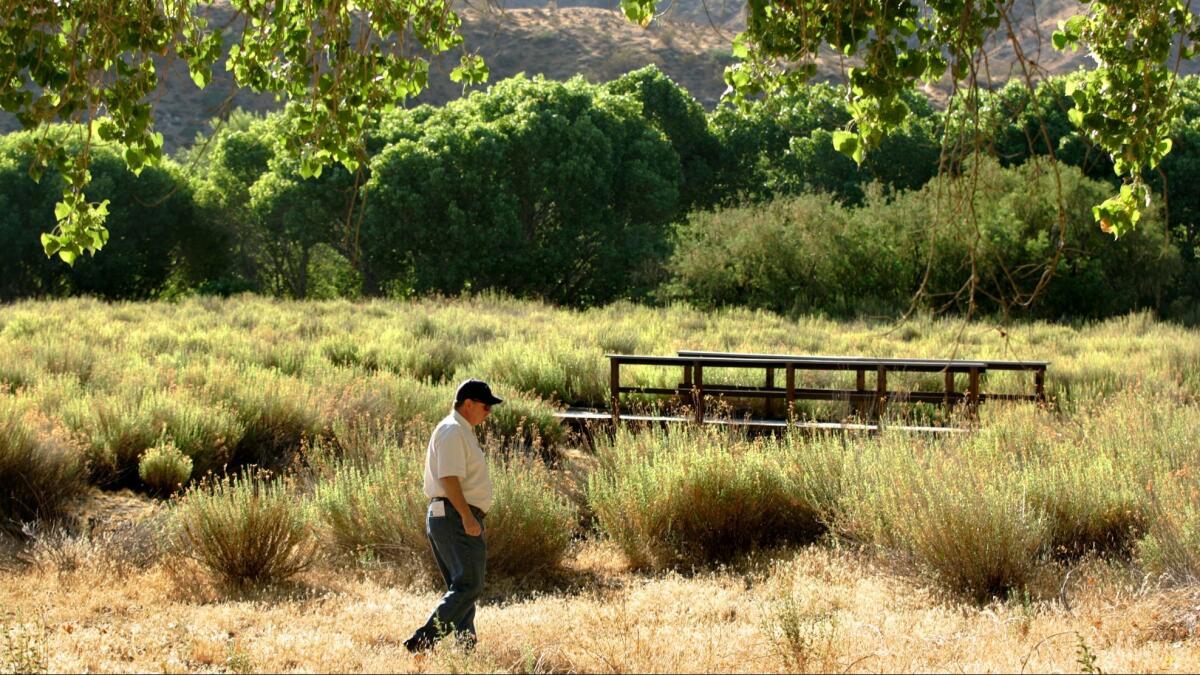Scientists try bacteria to halt invasive cheatgrass overwhelming the West

- Share via
Reporting from BOISE, Idaho — It sounds like science fiction: An unstoppable invader is taking over the West, and the best hope to stop its relentless advance is a small team of anonymous scientists.
But that’s what is happening in southwest Idaho, where experiments are underway to determine whether soil bacteria can halt the century-long assault of nonnative cheatgrass, which sends out roots that cheat other plants of water in the spring.
“We hope that we can identify the effectiveness of the bacteria on annual grasses and to identify non-target risk effects,” said Matt Germino, a research ecologist with the U.S. Geological Survey running the experiments at three sites of about an acre each.
Cheatgrass dries out in the summer, transforming into extraordinarily effective tinder for wildfires. The fires then kill competing native plants and destroy habitat needed by cattle ranchers and more than 300 species of wildlife, including the imperiled sage grouse bird.
The results are huge, cheatgrass-filled landscapes that serve as fuel for frequent wildfires, some reaching hundreds of square miles.
Ann Kennedy, a soil microbiologist with the U.S. Department of Agriculture’s Agricultural Research Service in Washington state, has sorted through 25,000 strains of naturally occurring soil bacteria to find a few that can stop cheatgrass root growth.
The bacteria strains she found are active in the spring at the same time as cheatgrass.
“In the spring they come up great guns, which then doesn’t let that plant grow very well in the spring, or even over winter very well,” she said. “You can draw down the seed bank of these annual weeds to where basically they’re gone.”
The strategy is to use the bacteria, possibly with some combination of herbicide, to eliminate cheatgrass long enough so that native plants can get established and fend off cheatgrass themselves.
The experiments in Idaho are part of a much larger plan following Interior Secretary Sally Jewell’s five-page secretarial order in early 2015 calling for a “science-based” approach to safeguard the greater sage grouse bird while contending with fires that have been especially destructive in the Great Basin area that includes parts of Idaho, Nevada, California, Utah and Oregon.
The ground-dwelling, chicken-sized birds are found in 11 Western states, where between 200,000 and 500,000 remain, down from a peak population of about 16 million. The males are known for their strutting courtship ritual on breeding grounds called leks, and produce a bubble-type sound from a pair of inflated air sacks on their necks.
They depend on sagebrush for food year-round, and hens nest underneath the sagebrush plants. Tall native grasses help screen the hens and their eggs and chicks from predators.
Late last month the Interior Department released a 139-page plan that serves as a how-to guide for the order. It identifies knowledge gaps as scientists try to find the best approach to restore and protect about 500,000 square miles of sagebrush steppe crucial for sage grouse.
The federal government has been working to protect key habitat to avoid an Endangered Species Act listing for the greater sage grouse. The U.S. Fish and Wildlife Service will review the bird’s status within five years.
The Interior Department plan released last month identifies cheatgrass as one of the toughest problems. If Germino succeeds in finding the right combination of bacteria treatments, that could change. Some results are expected within a year, but more will be known in five years.
But even if successful, he said, cheatgrass is only a symptom of a larger problem facing Western rangelands.
“It’s unlikely that any one technology will be the magic bullet,” he said. “Cheatgrass has come to dominate our lands. Chances are there are fundamental problems in the health of the land, or how we are treating the land.”
The invasive weed arrived in North America in straw packing material and packages of grain seed from Europe and Asia in the mid-1800s.
Ridler writes for the Associated Press.
ALSO
Climate change is real: Just ask the Pentagon
How one scientist came to defend animals used in research
Former soldiers say California Guard never paid bonuses it promised to interpreters in war zones
More to Read
Sign up for Essential California
The most important California stories and recommendations in your inbox every morning.
You may occasionally receive promotional content from the Los Angeles Times.













